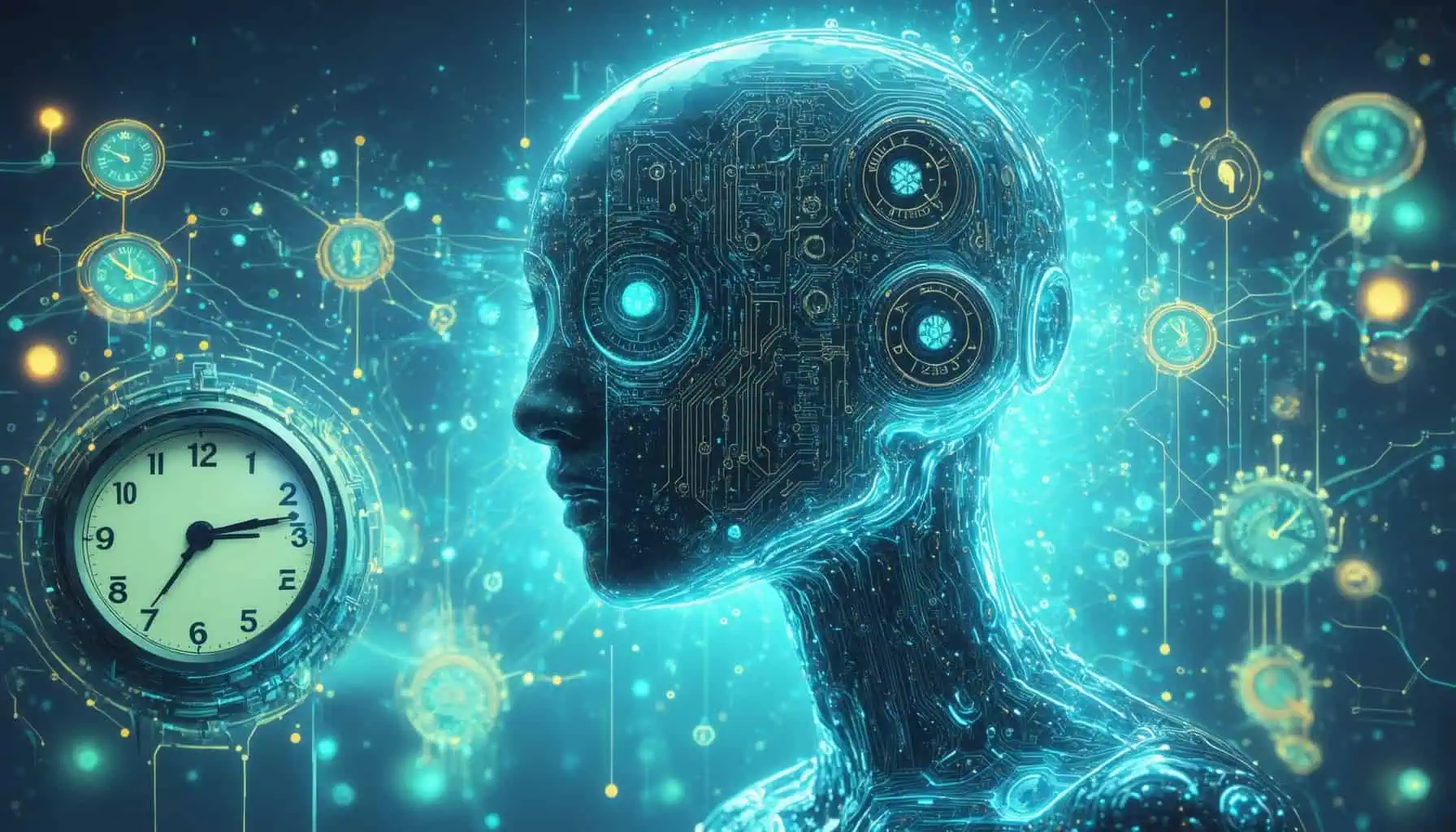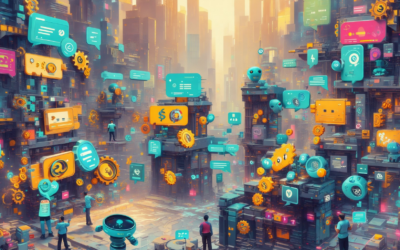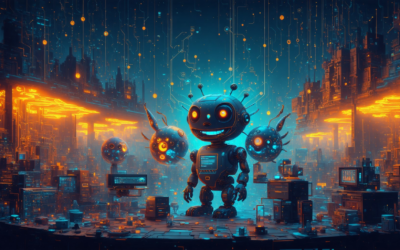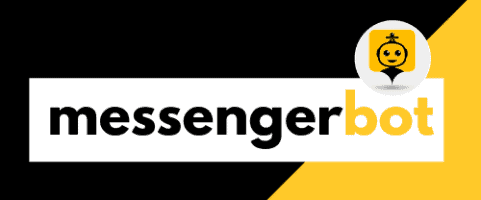Key Takeaways
- Transformative Technology: Chatbot AI is reshaping interactions between businesses and consumers, driving efficiency and enhancing user engagement.
- Advanced Features: Key features include Natural Language Processing (NLP) and Machine Learning, enabling personalized, context-aware conversations.
- Safety First: Understanding data privacy and using AI detector tools are essential for ensuring safe and ethical chatbot interactions.
- Industry Applications: Chatbots are widely used for customer service, lead generation, and personal assistance across various sectors.
- Future Trends: Expect advancements in personalization, multilingual capabilities, and integration with emerging AI technologies, enhancing user experiences.
In today’s rapidly evolving digital landscape, chatbot AI has emerged as a transformative technology, reshaping how businesses and consumers interact. This article delves into the multifaceted world of chatbot AI, exploring its foundational concepts, the evolution of its technology, and the key features that make it indispensable in modern communication. We will also compare the best AI chatbot options available today, including insights from user reviews on platforms like Reddit, to help you determine which chatbot suits your needs. Additionally, we will address pressing questions such as the safety of using chatbot AI, the ownership dynamics surrounding popular models like ChatGPT, and the implications of free versus paid services. By the end of this exploration, you will have a comprehensive understanding of chatbot AI, empowering you to make informed decisions in this exciting domain.
What is a chatbot AI?
Understanding the Basics of Chatbot AI
A chatbot AI is an advanced computer program designed to simulate human-like conversations with users through text or voice interactions. While not all chatbots utilize artificial intelligence, contemporary chatbot systems increasingly incorporate AI technologies, particularly natural language processing (NLP), to enhance their conversational capabilities.
The Evolution of Chatbot AI Technology
The evolution of chatbot AI technology has been remarkable, transitioning from simple rule-based systems to sophisticated AI-driven solutions. Early chatbots operated on predefined scripts, limiting their ability to engage in meaningful conversations. However, advancements in NLP and machine learning have revolutionized chatbot capabilities, enabling them to understand context, learn from interactions, and provide personalized responses. This evolution has made chatbot AI an essential tool for businesses aiming to improve customer engagement and streamline operations.
Key Features of Chatbot AI
Key features of chatbot AI include:
- Natural Language Processing (NLP): This technology enables chatbots to understand, interpret, and respond to user inquiries in a way that mimics human conversation. NLP allows chatbots to process language nuances, slang, and context, improving the overall user experience.
- Machine Learning: Many chatbots employ machine learning algorithms to learn from interactions over time, allowing them to improve their responses and adapt to user preferences. This continuous learning process enhances the chatbot’s ability to handle complex queries.
- Integration with Messaging Platforms: Chatbot AIs can be integrated into various messaging platforms, such as Facebook Messenger, enabling businesses to engage with customers directly where they communicate most. This integration facilitates real-time customer support and interaction.
- Use Cases: Chatbots are widely used across industries for customer service, lead generation, and personal assistance. They can handle inquiries, provide product recommendations, and even facilitate transactions, making them invaluable tools for businesses looking to enhance customer engagement.
- Benefits: The implementation of chatbot AI can lead to increased efficiency, reduced operational costs, and improved customer satisfaction. By automating routine inquiries, businesses can allocate human resources to more complex tasks, ultimately enhancing service quality.
For further reading on the evolution and impact of chatbot technology, refer to sources such as The Future of Chatbots: Trends and Predictions by Gartner and Conversational AI: The Future of Customer Experience by McKinsey & Company.
What is a chatbot AI?
Chatbot AI refers to artificial intelligence systems designed to simulate human conversation through text or voice interactions. These systems leverage natural language processing (NLP) to understand user inquiries and respond appropriately, making them invaluable tools for businesses looking to enhance customer engagement. By automating responses and managing interactions, chatbot AI can significantly improve operational efficiency and user satisfaction.
Understanding the Basics of Chatbot AI
The evolution of chatbot AI technology has transformed how businesses interact with their customers. Initially, chatbots were simple rule-based systems that could only respond to specific commands. However, advancements in machine learning and NLP have led to the development of sophisticated AI chatbots capable of understanding context and providing personalized responses. This evolution has made chatbot AI an essential component of modern digital communication strategies.
The Evolution of Chatbot AI Technology
Over the years, chatbot AI has progressed from basic scripted responses to advanced systems that utilize deep learning algorithms. Early chatbots, like ELIZA, operated on predefined scripts, limiting their ability to engage in meaningful conversations. Today, platforms such as Brain Pod AI offer advanced functionalities, including multilingual support and integration with various digital platforms, enhancing user interaction across channels.
Key Features of Chatbot AI
Modern chatbot AI systems come equipped with several key features that enhance their functionality:
- Automated Responses: Chatbot AI can provide instant answers to user queries, reducing wait times and improving customer satisfaction.
- Workflow Automation: These systems can automate repetitive tasks, allowing businesses to focus on more complex issues.
- Lead Generation: By engaging users through interactive conversations, chatbot AI can effectively capture leads and drive conversions.
- Multilingual Support: Many AI chatbots can communicate in multiple languages, broadening their reach and accessibility.
- Analytics: Chatbot AI provides insights into user interactions, helping businesses refine their strategies and improve engagement.
For more insights on how chatbot AI can enhance your business, explore our guide on AI chatbot uses and benefits.
Ownership and Development of Chatbot AI
Understanding the ownership and development landscape of chatbot AI is crucial for grasping its evolution and future potential. Various companies and individuals have played significant roles in shaping this technology, with notable figures like Elon Musk contributing to the broader field of artificial intelligence. While Musk is not a direct owner of any specific chatbot, his involvement in AI initiatives, including OpenAI, has influenced the direction of AI development, including chatbot AI.
The Role of Elon Musk in AI Development
Elon Musk, a prominent figure in technology and innovation, co-founded OpenAI, the organization behind the development of ChatGPT. His vision for AI emphasizes safety and ethical considerations, aiming to ensure that artificial intelligence benefits humanity. Musk’s advocacy for responsible AI development has sparked discussions about the implications of AI chatbots in various sectors, from customer service to creative industries. His influence extends to promoting transparency and accountability in AI technologies, which is vital for the safe deployment of chatbot AI.
Major Players in the Chatbot AI Industry
The chatbot AI industry features several key players, each contributing unique technologies and solutions. Companies like Brain Pod AI offer advanced AI chatbots that integrate functionalities such as image generation and multilingual support. Other notable competitors include established platforms like ChatGPT and various AI chatbot apps that cater to different business needs. Understanding these players helps users identify the best solutions for their specific requirements, whether for customer engagement, lead generation, or enhancing user experience.
Evaluating the Safety of Chatbot AI
As the use of chatbot AI becomes increasingly prevalent, understanding its safety is paramount for users and businesses alike. The integration of artificial intelligence into communication tools raises questions about data privacy, security, and the ethical implications of AI interactions. This section delves into the measures that can be taken to ensure safe usage of chatbot AI and the tools available to assess their reliability.
Understanding AI Detector Tools for Safety
To ensure the safety of AI chatbots, various AI detector tools have emerged. These tools are designed to evaluate the responses generated by chatbots, ensuring they align with safety standards and ethical guidelines. For instance, an artificial intelligence detector can analyze chatbot interactions to identify potentially harmful or misleading content. Utilizing such tools helps businesses maintain a trustworthy environment for users.
Some popular options include:
- AI Check: This tool assesses the reliability of chatbot responses, flagging any inappropriate or unsafe content.
- AI Detection Free: A free service that allows users to evaluate chatbot interactions without incurring costs.
- AI Checker: This tool focuses on ensuring that the chatbot adheres to ethical standards in its responses.
By implementing these tools, businesses can enhance the safety of their AI chatbot online interactions, fostering user confidence and satisfaction.
Best Practices for Safe Chatbot AI Usage
To maximize the safety of chatbot AI, it is essential to follow best practices that mitigate risks associated with AI interactions. Here are some key recommendations:
- Regular Monitoring: Continuously monitor chatbot interactions to identify and rectify any inappropriate responses.
- User Feedback: Encourage users to provide feedback on their experiences, which can help improve the chatbot’s performance and safety.
- Data Privacy Compliance: Ensure that the chatbot complies with data protection regulations, safeguarding user information.
- Transparent Communication: Clearly inform users about how their data will be used and the capabilities of the chatbot.
By adhering to these practices, businesses can create a safer environment for users engaging with chatbot AI, ultimately enhancing the overall user experience.
Evaluating the Safety of Chatbot AI
When considering the use of chatbot AI, it’s essential to evaluate its safety. AI chatbots can be safe to use, but there are important considerations to keep in mind regarding data privacy and security. Here are key points to consider:
Understanding AI Detector Tools for Safety
AI detector tools play a crucial role in ensuring the safety of AI chatbots. These tools help identify potential risks associated with the use of artificial intelligence chat systems. They can detect anomalies in data handling and flag any suspicious activities that may compromise user privacy. Utilizing an AI detector can provide peace of mind, ensuring that the chatbot adheres to safety standards and best practices.
Best Practices for Safe Chatbot AI Usage
To maximize safety while using chatbot AI, consider the following best practices:
- Data Storage and Security Risks: Be aware that AI chatbots store user data on servers, which can be vulnerable to hacking. Implementing robust security measures is essential to protect this data.
- User Privacy: Avoid sharing personal information with AI chatbots. Be cautious about the details you disclose, as this data may be stored and used in ways that do not align with your expectations.
- Transparency and Consent: Review the privacy policies of AI chatbots to understand how your data is handled. Ensure that the service complies with regulations like GDPR.
- Choosing Reputable Services: Opt for established AI chatbot platforms that prioritize user security. Research their reputation and read user reviews to gauge reliability.
- Regular Updates and Security Practices: Ensure that the chatbot you are using receives regular updates to address security vulnerabilities.
By following these best practices, users can enjoy the benefits of AI chatbots while minimizing risks associated with data privacy and security.
Chatbot AI Online: Accessing AI Chatbots
Accessing chatbot AI online has never been easier, thanks to the proliferation of platforms that offer user-friendly interfaces and robust functionalities. These AI chatbots are designed to enhance user interactions across various digital channels, making them an essential tool for businesses and individuals alike.
How to Use Chatbot AI Online Effectively
To maximize the benefits of chatbot AI, consider the following strategies:
- Choose the Right Platform: Select an AI chatbot that aligns with your needs. For instance, platforms like Brain Pod AI offer versatile AI chat assistants that can be tailored for specific tasks.
- Integrate Seamlessly: Ensure that your chatbot integrates well with existing systems, such as CRM tools and social media platforms, to streamline communication and enhance user experience.
- Utilize Automation Features: Leverage automated responses and workflows to handle common inquiries efficiently, reducing the need for constant human oversight.
- Monitor and Optimize: Regularly analyze chatbot performance metrics to identify areas for improvement. This can include user engagement rates and response accuracy.
By implementing these strategies, users can effectively harness the power of chatbot AI to improve communication and engagement.
The Future of Chatbot AI in Online Interactions
The future of chatbot AI is poised for significant advancements, driven by ongoing developments in artificial intelligence and machine learning. Here are some trends to watch:
- Enhanced Natural Language Processing: As NLP technology evolves, chatbots will become more adept at understanding and responding to complex user queries, making interactions feel more human-like.
- Increased Personalization: Future chatbots will utilize data analytics to provide personalized experiences, tailoring responses based on user preferences and past interactions.
- Broader Integration with AI Technologies: Expect to see more integration with AI tools, such as AI image generators, allowing chatbots to provide visual content alongside text-based responses.
- Multilingual Capabilities: As global communication expands, chatbots will increasingly support multiple languages, enabling businesses to reach a wider audience.
These advancements will not only enhance user experience but also redefine how businesses engage with their customers online, making chatbot AI an indispensable asset in the digital landscape.
Chatbot AI Online: Accessing AI Chatbots
Accessing chatbot AI online has become increasingly essential for businesses and individuals looking to enhance their digital communication. With various platforms available, understanding how to effectively use chatbot AI can significantly improve user engagement and streamline interactions.
How to Use Chatbot AI Online Effectively
To maximize the benefits of chatbot AI online, consider the following strategies:
- Choose the Right Platform: Select a chatbot AI platform that aligns with your needs. Options like Brain Pod AI offer versatile features, including multilingual support and integration capabilities.
- Define Clear Objectives: Establish what you want to achieve with your chatbot, whether it’s lead generation, customer support, or enhancing user experience.
- Utilize Automation Features: Leverage automated responses and workflows to ensure timely and relevant interactions with users, reducing the need for constant human oversight.
- Monitor Performance: Regularly analyze engagement metrics to understand user behavior and optimize your chatbot’s responses accordingly. Tools like Messenger Bot provide analytics to track performance effectively.
The Future of Chatbot AI in Online Interactions
The future of chatbot AI looks promising, with advancements in artificial intelligence and natural language processing (NLP) paving the way for more sophisticated interactions. Key trends include:
- Enhanced Personalization: Future chatbot AI will leverage data to provide personalized experiences, tailoring responses based on user preferences and past interactions.
- Integration with Other Technologies: Expect to see chatbot AI integrated with other emerging technologies, such as AI image generators and voice recognition systems, creating a seamless user experience.
- Increased Use of AI Detectors: As chatbot AI becomes more prevalent, tools like AI checkers will play a crucial role in ensuring the safety and reliability of interactions.
- Broader Applications: From e-commerce to healthcare, the applications of chatbot AI will expand, making it an indispensable tool across various industries.







